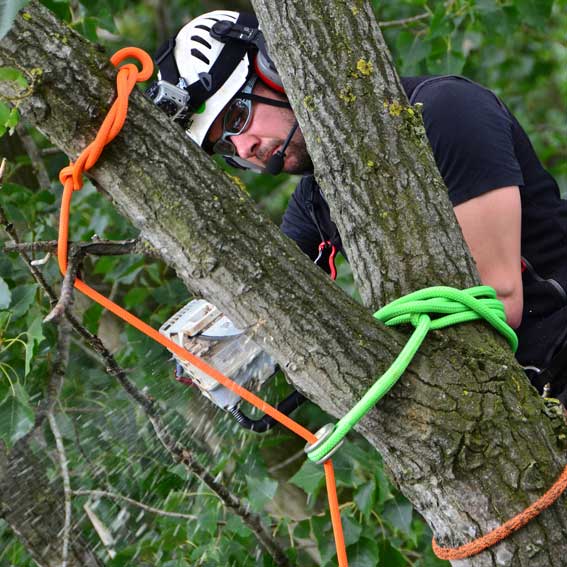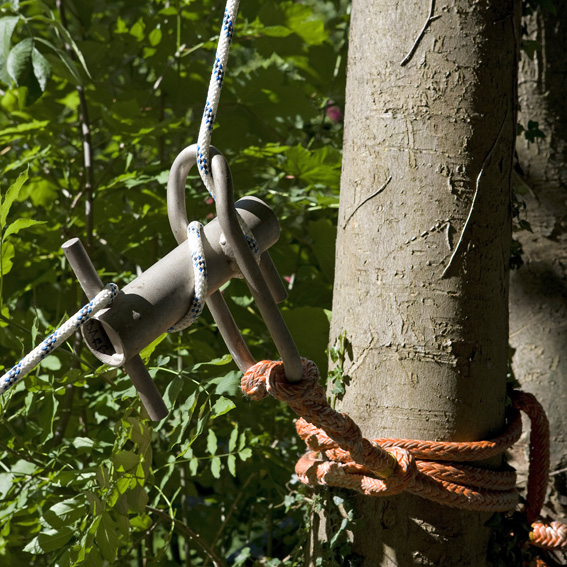
The Essential Gear Guide for Basic Rigging for Arborists
Tree rigging, for those not already familiar with this term, is the method by which we dismantle and lower branches and trunk sections of trees. Ranging from wholesale felling, to awkwardly shaped branches and tight drop zones requiring highly controlled movement, rigging can be one of the most complex operations an Arborist can perform.
Rigging necessitates a vast range of knowledge on subjects as varied as wood properties, equipment ratings, physics, and rope strengths – as well as an established practice of good working communication between everyone on the team.
Knowing what gear is right for the job is essential to safe and effective performance. In this guide to rigging, we’re going to give you an overview of the essential gear every arborist needs in order to rig productively and in accordance with personal and workplace safety regulations.
Safety Concerns Whilst Rigging
Safety whilst doing any arboriculture centred job is important but the risks associated with rigging can be fatal – or in the case or property, highly expensive! Proper rigging is an art based on training and experience.
Not only are you and your team at risk from working at heights but when rigging you are also at risk from the use of powerful machinery, suspended sections of trees, and the practical risks of lowering timber around the property or in the vicinity of the general public. There are some safety considerations that are unique to the complex requirements of rigging and ought to be kept in mind prior to undertaking a job.
One aspect of rigging that you should always be wary of is “chunking out” large trunk sections of wood that are vertically rigged upon themselves. When rigging it is important to always be aware of the forces that can be generated by removing and dropping wood via ropes. This force must go somewhere, so you must be able to minimise the shock-load and manage friction efficiently. This can be done by using equipment such as a pre-tensioning device or a friction bollard, in conjunction with professional rigging ropes that are sufficiently rated for the required load.
The rigging system should be constructed to withstand the maximum shock-load potential, in case of unexpected shock-loading when the rigged piece is “snubbed off” and not gradually decelerated.
Rigging also requires an understanding of the effects on the rope with the various knots and hitches used. Knots will significantly reduce rope strength and reduces the working load limit recommended by a manufacturer. Lowering too quickly and branch sections that are too heavy will damage ropes, leading to significant weakening of the rope.
When rigging, the user must always be responsible for;
- Using appropriate rigging gear with a suitable weight capacity for the job
- Using rigging gear that is in accordance with industry regulations and the manufacturers’ recommendations
- Conducting regular inspection of the rigging gear

The Gear Guide to Basic Tree Rigging
When you’ve got heavy sections to bring down safely, you’ve got a lot riding on your gear. The safety of your workers, the integrity of property in the vicinity, and the reputation of your company – these all depend on rigging safely and professionally.
With the huge diversity of equipment currently on the market, every tree rigging situation can be made as a complex or as simple as the team are happy with. Remember that the more complex the setup, the more potential risks – and any system is only as strong as the weakest link. This may be an apparently insignificant component, so don’t forget to assess all the equipment in the chain before you begin.
With forethought, correct application of gear and techniques and teamwork, tree rigging has almost endless opportunities for safe and efficient – and fun! – lowering of branches and timber from trees.
What is Basic Tree Rigging?
Tree Rigging can be as basic as attaching a rope to the branch to be removed, through a pulley, and down to the grounds person. As the climber cuts the branch off, the grounds person controls the tail end thus lowering the load.
This technique, however, adds in variables that are hard to account for – the weight of the section and the level of tension on the line. For anything other than very small sections (and as general good practice) a friction device should be added in for control.
From this basic setup, as many additional elements and pieces of equipment can be added into the system as needed, for example, a speedline to take timber to a remote drop zone, or a block and tackle system to pre-tension the line.
By rigging through a pulley block fixed to the tree via a dead-eye sling, rather than the old method of directly over a branch, not only do you save a lot of wear on the rope and damage to the tree, but the rigging point can be easily positioned and repositioned on the tree for multiple lowering options.
At ground level, the friction can be controlled in various ways depending on the nature and extent of the job – at the most basic level, a capstan such as the Buckingham Large Capstan (Portawrap) secured to the tree by a whoopie sling, or for more ease of use and better control, a bollard such as the Mountable Lowering Bollard, which unlike a capstan, remains in position even when not under tension.

Gear Needed for Basic Rigging
- Rope
- Rope bag
- Rigging Block
- Dead Eye Sling
- Portawrap and Adjustable Whoopie Sling or Bollard
The Zega Sentry Rope Bag, in both medium and large, is an extremely durable rope bag.
When it comes to ropes for rigging you can’t go far wrong with the Zega HeavyRig ropes that come in 13mm, 16mm and 19mm diameters. These feature Zega’s TechnaGlide™ water-resistant coating giving a high resistance to abrasion, and the XtraFlex™ structure makes the rope very supple to handle.
In terms of rigging blocks, you can’t really go wrong with ISC hardware. When it comes to bollards, the K786 Mountable Lowering Bollard for general lowering operations is a good sturdy workhorse, whilst the K787 Heavy Duty Bollard is the monster of the range, for use when dismantling (the K786 has rubber backing blocks so doesn’t damage the tree hence can be used on a healthy tree that you’re keeping, whereas K787 has ‘teeth’ on the backing plate which bite into the tree, meaning that whilst it is really secure and hence very strong for taking out large sections, it does impact the tree).
If you’re wanting to set up a new team, or replace a lot of gear, a rigging kit is a good choice as it contains all the gear to get you started at a deal price – such as our startup and premier rigging versions.
Built from tough, waterproof, UV resistant PVC, with the Sentry range of rope backpacks from Zega remain upright and open, unsupported, for easy access, giving it it’s unique name. With Internal ‘daisy chain’ webbing loops for hanging karabiners and tool clips, reinforced load bearing seams, a lid, scuff resistant base and two side bellows pockets, the Sentry is a superb quality heavy duty bag, ideal for the heavy gear that rigging requires.
